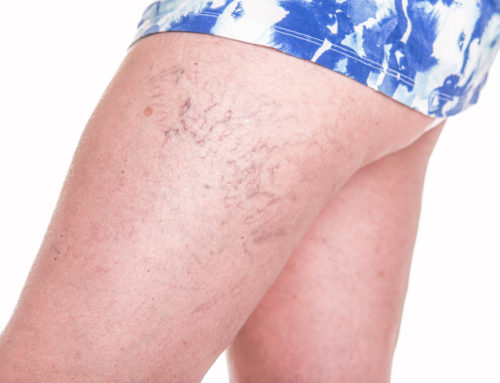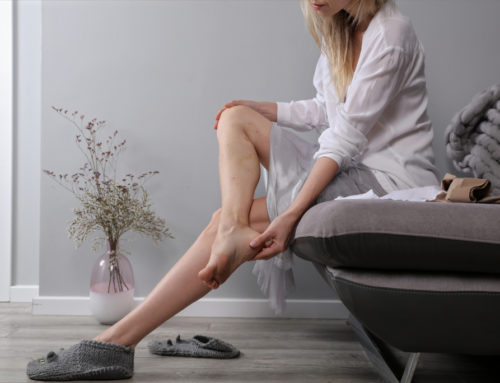Cosmetic tattooing and permanent makeup have definitely been on the rise over the last couple of years. You can now walk into a salon and get a tattoo that alters your lip color or changes your eyebrow shape.
Another popular service that has cropped up recently is the practice of using tattoos to cover up scars and other aesthetic problems. Tattoos can be effective ways to beautifully mask stretch marks and scars. However, tattoos may not be the best way to conceal spider veins and varicose veins.
Tattoo On Veins — Good or Bad?
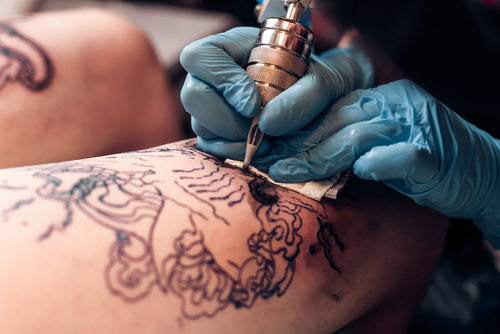
Have you ever seen someone get a large leg tattoo to cover up an unsightly varicose vein? Branches, dark designs, or large multicolored images are all common ways people cover up dark spider veins and bulging varicose veins. However, there are many factors to consider before getting inked, as this may not be safe or effective for concealing the veins.
Can You Tattoo Over Spider Veins?
When you get a tattoo, a tattoo artist uses a rotary gun with tattoo-specific needles to inject pigment, or ink, under your epidermis and into your dermis skin layer.
How deep does the tattoo needle go? If done correctly, the needle should go about 1.5 to 2 millimeters under the skin. While not likely, there is a possibility that a tattoo needle could go too far and puncture the hypodermis and rupture a vein. Tattoos typically do not puncture regular veins, but there is a higher risk of encountering more problems with spider veins.
So, yes, you technically could try to tattoo over a spider vein. Having said that, tattooing over spider and varicose veins is not recommended for a variety of both health and aesthetic concerns.
Can You Tattoo Over a Varicose Vein?
Varicose veins are large, twisted veins that appear rope-like and may be blue or purple in color. These enlarged veins are often symptoms of a venous disease that causes valve malfunctions and abnormal pooling in veins. Although they are not severe most of the time, they can be unsightly.
So, can you cover up varicose veins with a tattoo? Again, technically, yes. However, it increases the risk of infection if the vein is ruptured. Even though it is unlikely the vein will rupture, it is an added risk to consider. Plus, tattooing over areas without veins is painful and will cause swelling. Tattooing over a sensitive area like a varicose vein will only exacerbate the pain and swelling.
On top of that, the bulging varicose veins may distort the tattoo design, and you may be unhappy with the results.
Aside from the tattoo itself, a vein specialist may have a more difficult time treating varicose veins covered by a tattoo. Treatment is more effective—and safer—when the physician can see the varicose vein clearly.
Before getting inked, consider these five of the main reasons why tattooing over spider veins is a bad solution to your vein problem:
- You can get more dark veins in the same area
- Tattooed veins are harder to treat
- Is it worth the risk?
- It could be more than little dark veins
- There are better options
1. There is a high likelihood of more spider and varicose veins appearing in the area.
Unfortunately, a patient who begins developing spider or varicose veins is very likely to develop more veins as time goes on. Genetics and gender make some people naturally more predisposed to this condition.
If you decide to get a cover-up tattoo, the artwork may only be a temporary fix. For example, while your new tattoo covers a few inches of spider veins, you are very likely to discover new spider veins popping up around the edges of the artwork in just a few years. Continuously attempting to cover every spider vein would not only be impractical but also costly.
2. The tattoo would make future vein treatment more difficult.
As with any medical procedure, it is easier to perform if your vein specialist can clearly see the area they need to treat. Tattoos, especially darker-toned ones, cover the exact area your doctor needs to examine.
Leaving the area clean and free of unnecessary obstructions, on the other hand, will make any future treatments a lot easier to perform. Treating spider veins and varicose veins may be vital to preventing blood clots and poor circulation down the road.
From an aesthetic point, tattoos look better on a blank canvas. Dark veins and bulging veins could distort the overall image and lead to disappointment. If you want a tattoo in a specific area that currently has visible dark veins, first seek treatment to create a beautiful blank canvas.
3. It’s an unnecessary health risk.
Although unlikely, it is still possible for a tattoo to cause further damage to a vein. As with any skin puncturing, a tattoo only increases your risks of infection and other complications.
However, if you do decide to move forward with getting a tattoo, do your due diligence beforehand. Find a reputable, clean tattoo parlor, and ask your tattooist about their process. Make sure that all of the tools used are sanitized before each use.
Although, a reputable tattoo artist may refuse to cover spider or varicose veins with a tattoo, for any of the reasons discussed here.
4. Your veins could mean something more serious.
You should always consult with a medical professional before forging ahead with a self-prescribed treatment. The simple truth is that a discolored vein may not always be a simple case of spider veins.
Regardless of the cause of the discoloration, covering it will only make it more difficult to evaluate. Worse, a tattoo can prevent you from noticing any alarming changes to your own veins. At the very least, try to come in for a vein evaluation before you attempt to cover up the area with artwork.
5. There are better treatment options.
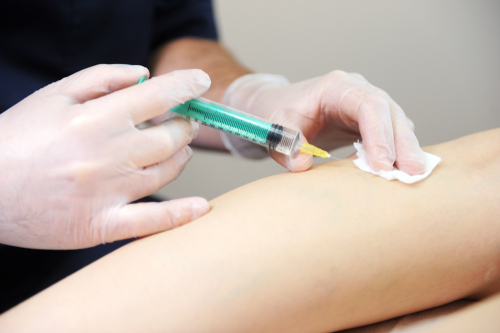
The good news about spider and varicose veins these days is that they are fairly easy to treat. Between sclerotherapy, venous ablation, and microphlebectomy, medical treatments are not only safe, but they are also very affordable.
In contrast, a tattoo is not guaranteed to come out correctly or cover the veins well. Instead of opting for a tattoo, try to reach out to a vein clinic first to ask about your medical options.
Can you get a tattoo after you treat a varicose vein?
Because you dream of the perfect tattoo on your legs, you treat your varicose veins to have a blank canvas. In theory, treating veins beforehand should work. However, there’s a chance that you can develop more varicose veins in the same area. In this case, your tattoo may become distorted, or your vein may be hard to access for treatment.
With lifestyle changes, you can decrease your risk of developing more varicose veins. But there is no guarantee it won’t happen again.
Can A Tattoo Cover Spider Veins?
The short answer to this is…it might. If executed correctly, a tattoo may be able to disguise some of your spider veins. You can easily browse the internet for many before and after photos. However, in most cases, you can still see the spider veins and varicose veins in the after photo. Fact is, covering up veins can lead to a distorted tattoo.
Furthermore, not only is tattooing over spider veins an unnecessary risk, but it’s also not the most practical solution. If you’re looking for a low-cost way to temporarily conceal the appearance of your veins, try a sunless tanning lotion or a makeup concealer instead. Both of these options are cheaper and safer. Plus, there are multiple sunless tanners and types of makeup for legs and body to choose from.
I already booked a tattoo appointment, but I just now realized I have spider veins where I want the tattoo. What should I do?
If you suddenly realize you have spider veins in the area you plan to get a tattoo, contact your tattoo artist immediately. They may have recommendations on changing the tattoo’s placement or design based on their professional experience.
The most common areas for spider veins are thighs, calves, ankles, feet, and face. We recommend avoiding these areas for tattoos.
The fact is, most people—especially women—have spider veins that pose no health risk. In some cases, however, spider veins could be an early sign of Chronic Venous Insufficiency (CVI). See a vein specialist for screening and preventative treatment if you have a family history of venous diseases and other risk factors. Your vein specialist will know if your spider veins pose a risk or are safe to tattoo.
Can I Tattoo Over Normal Veins?
You can always see some veins that aren’t varicose or spider veins. For example, you likely have visible veins on your wrist or the backs of your hands that may protrude slightly.
Tattooing over these healthy veins poses no greater risk than tattooing over normal skin. In fact, wrist tattoos are quite popular, and people rarely have issues when they tattoo over wrist veins.
However, depending on how visible these healthy veins are, they could also distort the tattoo design. However, there are especially talented tattoo artists who use veins as inspiration and freehand designs that can mimic the look and feel of veins in a beautiful and abstract way.
Bottom Line:
In conclusion, the best and safest option is to not tattoo over a varicose vein to avoid very serious complications and undesirable outcomes.
Instead, it is crucial first to seek a diagnosis from a vein specialist, who can assess the severity of the issue. By addressing the underlying problem and receiving appropriate care to treat varicose veins, you can ensure the health and appearance of your legs while avoiding potential risks and complications associated with tattooing over varicose veins.
How To Get Rid Of Spider Veins
As we mentioned earlier, there are plenty of minimally invasive procedures that can help treat your spider veins. Here are a couple:
Sclerotherapy
Sclerotherapy is one of the simplest procedures used to get rid of spider veins and varicose veins. During a sclerotherapy treatment, your vein specialist injects a solution directly into the damaged vein. This solution then irritates the lining of your vein and forces it to seal up. Eventually, the tissue is reabsorbed back into the body, and blood simply to a different, healthy vein.
Venous Ablation
Similar to sclerotherapy, venous ablation also functions by irritating the lining of a vein and forcing it to close. The main difference is that venous ablation utilizes radiofrequency (RF) energy instead of a liquid solution.
The good news is that both of these procedures are relatively quick and easy, with little to no downtime. Interested in booking your own sclerotherapy treatment? Simply call or fill out our online form, and someone from our team will reach out to help you schedule a consultation.
Spider Vein Removal
In the case that sclerotherapy and venous ablation don’t work, your vein specialist might recommend vein removal, called a microphlebectomy.During a microphlebectomy, your doctor creates small incisions and carefully removes the damaged veins. This procedure is quick and requires little to no recovery time.
Alternatives to Hiding Varicose Veins
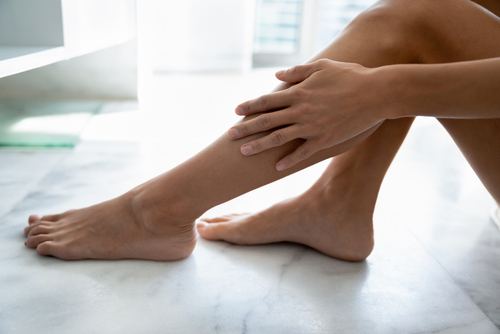
While there is no way to get rid of a spider vein on your own at home, there are a few ways to cover up spider veins if you don’t like their appearance. For example, a tanning lotion or makeup concealer for the legs and body can be used to cover up any discolored veins as needed.
Please keep in mind that without medical intervention, a spider vein is unlikely to disappear on its own.
How to Prevent Varicose Veins
To prevent varicose and bulging veins, several daily habit changes can help.
Maintaining a healthy lifestyle by engaging in regular exercise, such as walking, swimming, or cycling, promotes healthy blood circulation.
Avoiding prolonged sitting or standing by taking breaks and moving around throughout the day can also help improve circulation. It’s important to stay hydrated by drinking an adequate amount of water, which helps maintain healthy blood viscosity.
Wearing comfortable footwear with proper support and avoiding high heels or tight-fitting shoes that restrict blood flow can alleviate strain on the veins.
Additionally, elevating the legs above heart level while resting or sleeping can promote blood flow back to the heart. These simple yet effective strategies can contribute to preventing the development of varicose and bulging veins.
What Is The Cause Of Spider Veins?
The underlying cause of spider veins is the same as that of varicose veins – i.e., malfunctioning valves.
When a valve malfunctions and stops helping blood circulate, the blood often stagnates and begins pooling. As blood pools and begins straining against the walls of its vein, it can cause the vein to turn bluish-purple. These bluish-purple veins are called spider and varicose veins.
Some people are naturally predisposed to spider veins, but it’s not necessarily caused by any one thing that you do. Things such as genetics, gender, and weight can all be contributing factors that impact your risk of developing this condition.
Interested in lowering your risk of developing spider veins? Try to avoid sitting in one place for long periods. Instead, try to get up and walk around or stretch occasionally.
Varicose Veins Vs Spider Veins
Wondering what the difference between a varicose vein and a spider vein is? Here’s a quick compare and contrast:
Varicose veins tend to be large, bulging veins that are most commonly found in the legs. Appearance-wise, spider veins are significantly smaller and thinner and appear much closer to the surface of the skin.
Physically, neither condition is usually considered very harmful on its own. Having said that, varicose veins do tend to come with slightly more discomfort – ie, achiness or heaviness in the legs.
Spider Vein Treatment Near Me
Now that you’ve discovered good alternatives for covering up spider veins let’s talk about vein clinics. Here at VeinSolutions Flint, we are happy to provide treatment for spider and varicose veins and other vein conditions.
Interested in learning more about your treatment options? Simply visit our vein treatments page to learn more about sclerotherapy, microphlebectomy, and venous ablation.
To make an appointment with one of our vein specialists, call or fill out our handy online form, and someone from our team will be in touch as soon as possible. Don’t forget that our vein screenings are FREE, so there’s no reason to wait.
Request A Consultation
Give Us A Call:
(810) 232-3363
Give Us A Call:
(810) 232-3363

